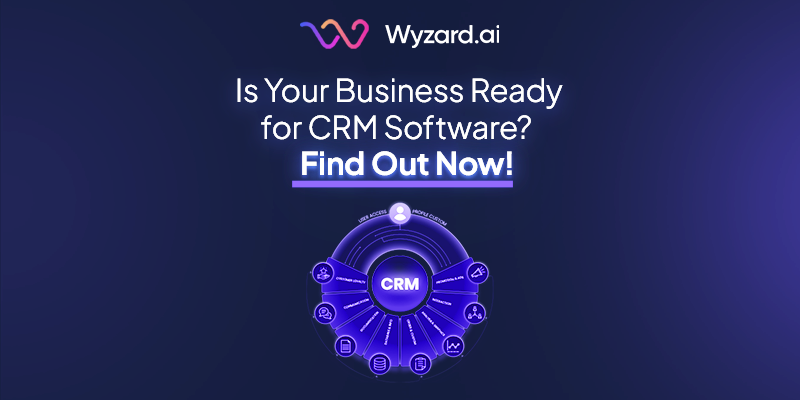Hi, I am Wyzard, your visionary guide in a world where the buying experience is transforming. The way we ...
23 SaaS Buying Mistakes Businesses Make and How to Avoid Them
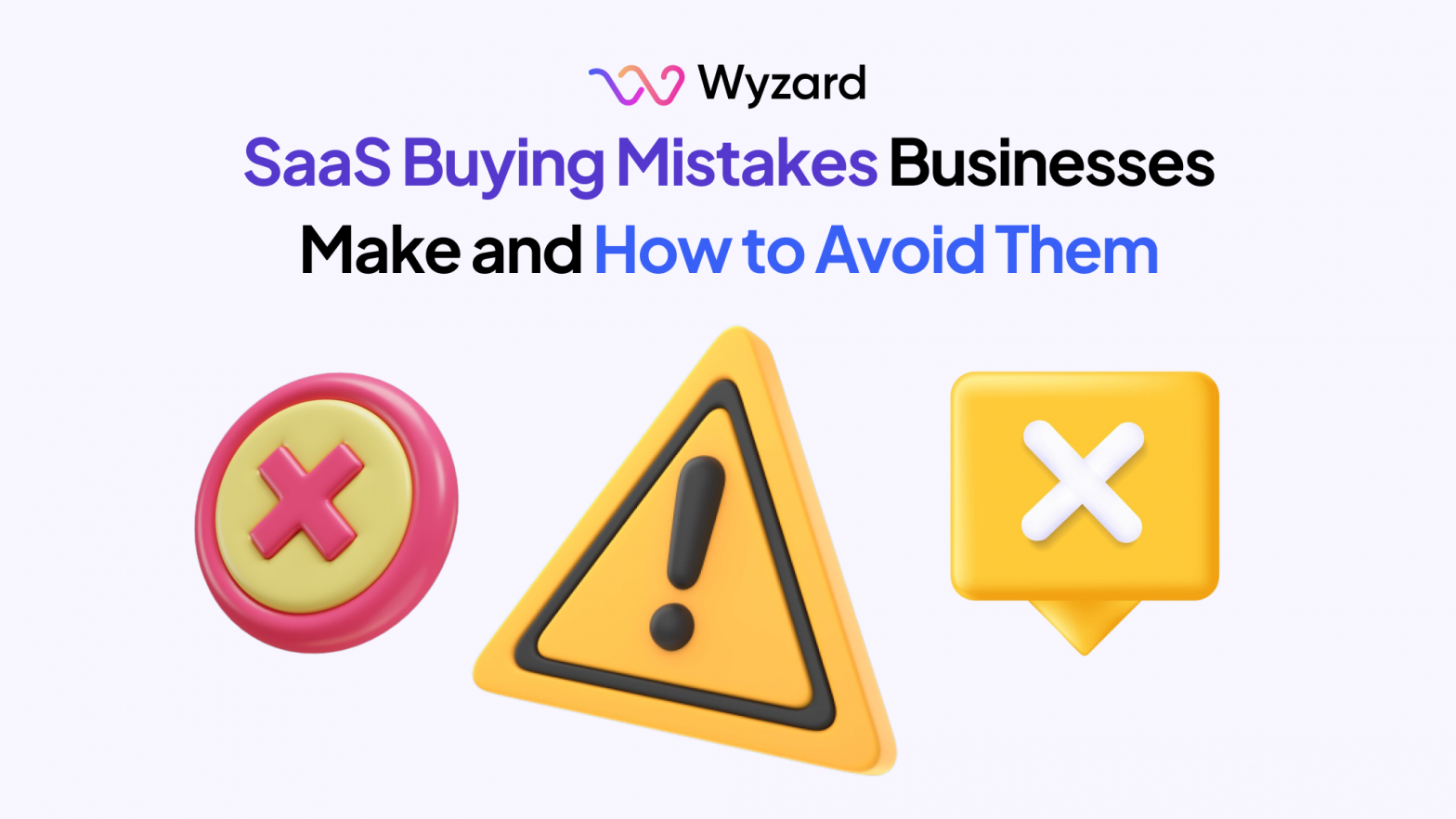

Subscribe Now
Companies across the globe are increasingly turning to Software as a Service (SaaS) solutions. However, managing your SaaS buying process can be challenging, with multiple moving parts to consider. This complexity often leads to costly mistakes that can impact your bottom line.
When buying SaaS, there are many moving parts to manage, from vendor selection to contract negotiations. The complexity of the SaaS buying process increases the likelihood of errors, which can have long-term financial consequences.
You might find yourself exceeding your budget, spending more than necessary, and eventually reducing the ROI of your SaaS purchases. This, in turn, can significantly affect your business’s profitability.
In this blog, we’ll look at some of the most common SaaS buying mistakes businesses across various industries make. We’ll also provide you with a practical solution to help you avoid these pitfalls.
Let’s dive right in!
Top 5 SaaS Buying Mistakes Businesses Make
Before we get a look at the industry-specific mistakes, here are some general SaaS buying mistakes that businesses often make.
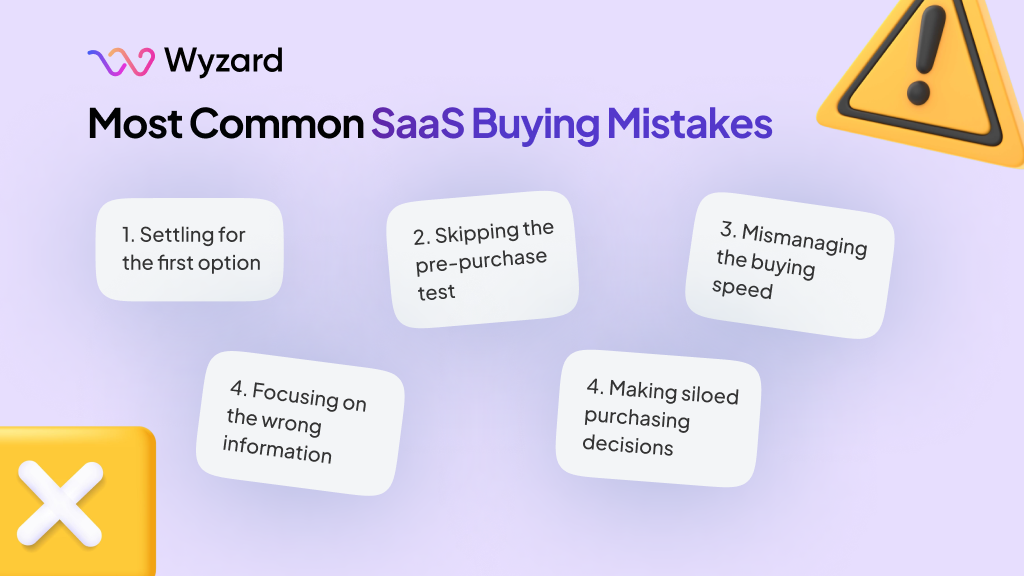
1. Settling for the first option
It’s tempting to go with the first solution that seems to fit. Many businesses, pressed for time, make this mistake.
They might stick with their current provider during renewals without exploring alternatives. However, this approach can lead to missed opportunities.
The SaaS industry is highly competitive, offering many options. To make the most of this, consider following the “three bids and a buy” approach. In this approach, you compare at least three top suppliers, allowing for an apples-to-apples comparison.
This helps you get competitive pricing and also helps you make data-driven decisions based on features, contract terms, and overall value.
2. Skipping the pre-purchase test
While sales pitches, demos, and office visits are helpful, nothing beats hands-on experience with a SaaS solution.
Gone are the days when getting a trial was challenging. Today, it should be the norm to test before you invest.
Most SaaS providers offer sandbox environments for testing. Take full advantage of these opportunities. Involve relevant team members in the testing process. It’s a crucial step to avoid buyer’s remorse and ensure that the chosen solution aligns with your company’s workflows and objectives.
3. Mismanaging the buying speed
When a need is identified, there’s often a sense of urgency. This can lead to rushing into a purchase without proper evaluation.
Moving too quickly often results in overlooking better options, inadequate vendor research, and poor negotiation outcomes.
On the flip side, moving too slowly can be equally problematic. Dragging out the process with lengthy RFPs can frustrate vendors and potentially close doors to good opportunities.
The key is to find a balance. Keep vendors in the loop, ask the right questions, and make decisions after thorough consideration.
This approach helps secure the best value for money and ensures you get a solution that truly meets your needs, all within a reasonable timeframe.
4. Focusing on the wrong information
When buying SaaS, sales teams will share a lot of information, highlighting their unique features. However, not all of it will be relevant to your business. It’s essential to focus on what matters most to your company.
For instance, a SaaS company might offer a pricing plan for up to 20 users, but if you only have ten employees, this won’t benefit you. Similarly, they might highlight their platform’s international capabilities, but this feature is unnecessary if your business operates only in one country. Another example is free access to an API, which is irrelevant if you plan to use the software through its interface only.
In short, don’t get distracted by flashy sales pitches. Understand your company’s specific needs and filter the information accordingly to make the best decision.
5. Making siloed purchasing decisions
As companies grow, a common mistake is allowing SaaS procurement decisions to be made at the departmental level. This approach often leads to redundancy and increased costs across the organization.
When different departments make independent SaaS buying decisions, it can result in multiple tools serving similar purposes. This inflates costs and creates inefficiencies in data management and cross-departmental collaboration.
A more strategic approach is to use platforms like Wyzard that identify the tool with the same functionality and help you switch to the most effective one. It also measures your buying power and uses it to get better software deals.
Biggest SaaS Buying Mistakes Tech Companies Make
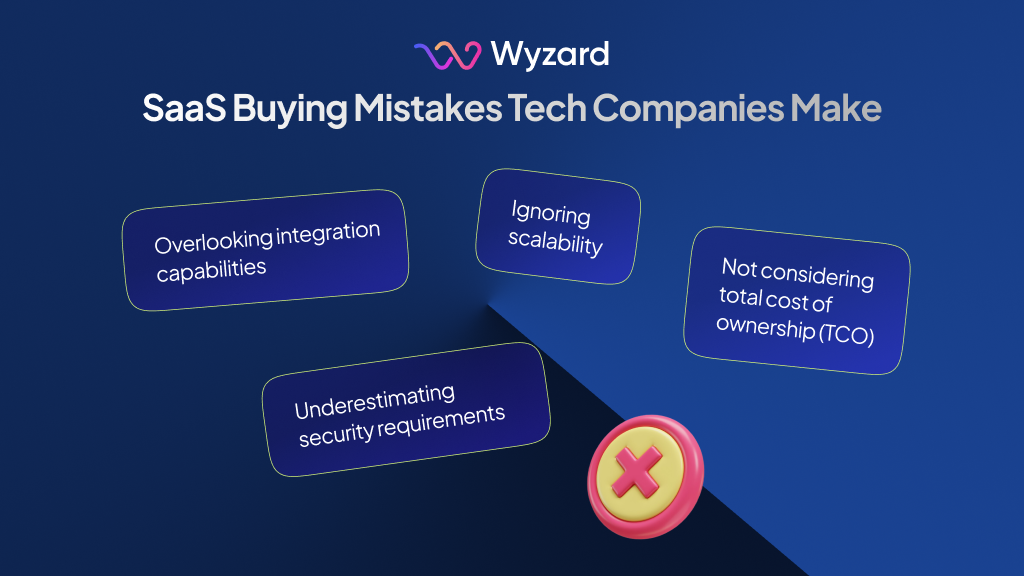
Tech companies face unique challenges when purchasing SaaS solutions due to their rapidly changing needs and high standards for technology.
Here are some common SaaS buying mistakes in this sector:
6. Overlooking integration capabilities
Tech companies often use a variety of tools in their day-to-day operations. When purchasing new SaaS products, it’s crucial to consider how well they integrate with existing systems.
Failing to do so can lead to problems like data silos. When systems don’t communicate effectively, information gets trapped in separate platforms, making it difficult to get a comprehensive view of operations.
Employees may need to switch between multiple non-integrated systems, reducing productivity and increasing the likelihood of errors. Even the IT team may need to spend considerable time and resources creating workarounds or custom integrations for poorly integrated systems.
7. Ignoring scalability
The tech industry is known for rapid growth, and software needs can change dramatically in a short time. Choosing a SaaS product without considering its scalability can lead to several issues:
- A solution that works for a team of 20 may not be suitable when the company expands to 200 employees.
- As data and user numbers increase, a non-scalable system may slow down.
- If the chosen SaaS can’t keep up with growth, the company may need to switch to a new system, which can be expensive and disruptive.
Tech companies should look for SaaS solutions that offer flexible pricing tiers and the ability to handle increased data and user loads without significant performance degradation.
8. Underestimating security requirements
Tech companies often handle sensitive data, including proprietary information and customer details. Choosing a SaaS product without adequate security measures can expose the company to significant risks, data breaches, and compliance issues with regulations like GDPR or CCPA. A security incident can severely damage a tech company’s reputation, potentially losing customers and partners.
When evaluating SaaS options, tech companies should thoroughly assess the vendor’s security practices, including data encryption, access controls, and regular security audits.
9. Not considering total cost of ownership (TCO)
Focusing solely on the initial subscription cost without considering long-term expenses can lead to budget overruns. Complex systems may require extensive training for staff, which can be a significant additional expense.
If the software needs to be tailored to specific needs or integrated with existing systems, this can add to the overall cost. Some vendors even charge extra for major upgrades or ongoing maintenance, which should be factored into the TCO.
Tech companies should carefully evaluate all potential costs associated with a SaaS solution over its expected lifetime, not just the upfront subscription fee.
Key SaaS Purchasing Mistakes in the Finance Industry
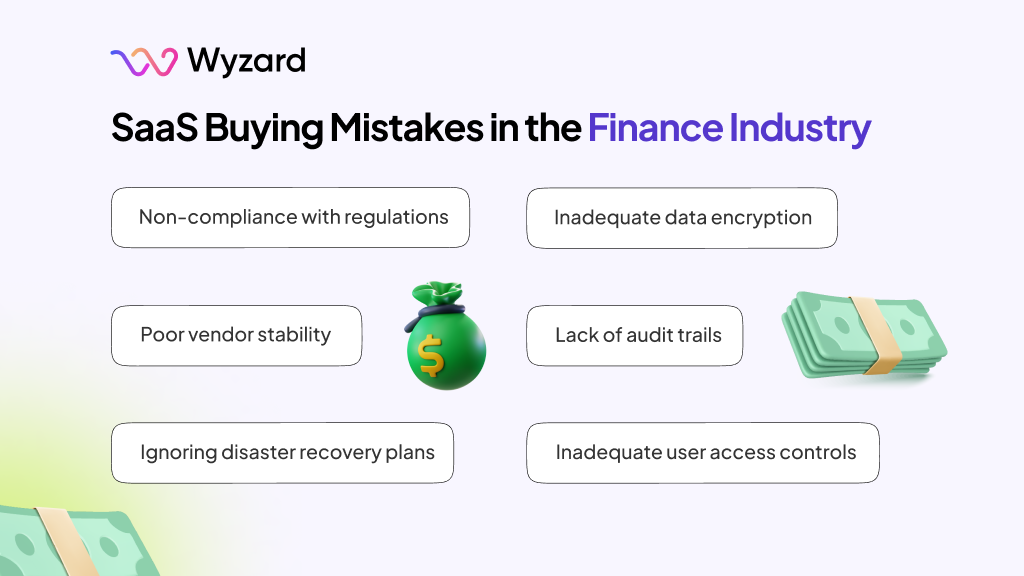
Due to the sensitive nature of financial data and the strict regulatory environment, finance companies can’t pick any software at random.
Here are six common SaaS buying mistakes businesses in the finance industry make:
10. Non-compliance with regulations
Financial institutions must adhere to strict regulations. Choosing non-compliant SaaS products can result in legal penalties, trigger intensive regulatory audits, and cause operational disruptions.
Finance companies should ensure any SaaS solution they consider is certified for relevant financial regulations and standards, such as SOX, PCI DSS, or FINRA, depending on their specific sector.
11. Inadequate data encryption
Financial data is highly sensitive, and inadequate encryption in SaaS solutions can lead to data breaches, loss of client trust, and regulatory non-compliance.
Finance companies should prioritize solutions offering robust encryption for data both in transit and at rest, preferably with options for customer-managed encryption keys, to protect sensitive information and maintain regulatory compliance.
12. Poor vendor stability
Selecting a SaaS vendor without assessing their financial stability and longevity can be risky for finance companies.
An unstable vendor may discontinue services, lack ongoing support and updates, or force migrations due to acquisitions or business model changes.
Thorough research into potential vendors’ financial health, funding status, and long-term business plans is crucial before committing to a SaaS solution.
13. Lack of audit trails
Detailed audit trails are essential for finance companies, both for compliance and internal monitoring. SaaS products lacking this feature can cause compliance issues, difficulties in fraud detection, and challenges in troubleshooting.
Finance companies should prioritize solutions offering robust, tamper-evident audit trails covering all significant user actions and system events to ensure transparency and regulatory compliance.
14. Ignoring disaster recovery plans
Not considering a vendor’s disaster recovery and business continuity plans can leave finance companies vulnerable to extended downtime and data loss. When evaluating SaaS vendors, finance companies should carefully review their disaster recovery and business continuity plans, including recovery time objectives (RTO) and recovery point objectives (RPO), to ensure business continuity.
15. Inadequate user access controls
Finance companies require strict access controls to protect sensitive information. Choosing a SaaS product with weak user management can lead to unauthorized access, difficulties in enforcing segregation of duties, and compliance violations. Look for solutions offering role-based access control, multi-factor authentication, and detailed logs of access attempts and changes to access permissions.
Avoid These SaaS Buying Mistakes in Healthcare
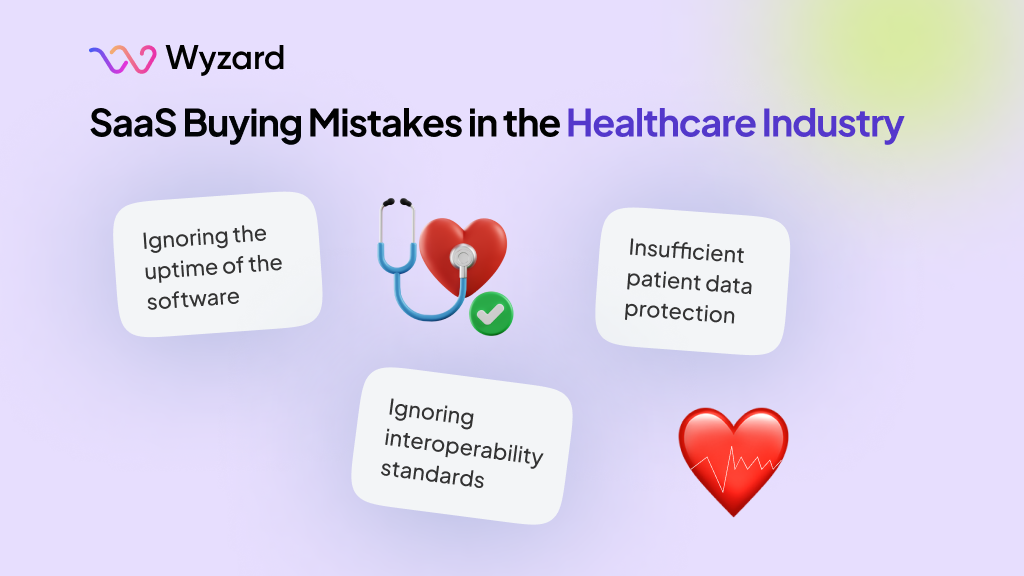
The healthcare industry has unique SaaS needs due to the sensitive nature of patient data and strict regulatory requirements. Here are three common SaaS buying mistakes in this sector:
16. Ignoring the uptime of the software
In the healthcare industry, emergencies and critical situations are a daily occurrence. This makes it essential for healthcare businesses to invest in software with high uptime.
Downtime can have severe consequences, including delayed treatments, compromised patient safety, and loss of critical data. There could be a scenario where a healthcare professional needs immediate access to patient records, but the software is down. This can lead to dangerous delays and potentially life-threatening situations.
Therefore, it’s crucial to ensure that the software you choose has a proven track record of high availability and reliability. Always check the service level agreements (SLAs) and uptime guarantees provided by the software vendor to avoid any disruptions in your critical operations.
17. Insufficient patient data protection
Protecting patient data goes beyond just HIPAA compliance. Inadequate data protection measures in a SaaS solution can lead to serious issues like data breaches when someone gets unauthorized access to sensitive patient information.
If patient data is compromised, it can severely damage the relationship between healthcare providers and their patients. Beyond regulatory fines, data breaches can expose healthcare providers to lawsuits from affected patients.
When evaluating SaaS options, healthcare providers should look for solutions with robust security features, including end-to-end encryption, multi-factor authentication, and regular security audits.
18. Ignoring interoperability standards
Healthcare systems need to communicate with each other efficiently. A SaaS product that doesn’t support interoperability can hinder patient care.
Lack of interoperability can result in incomplete patient information across different systems. And the healthcare staff may need to transfer data between systems manually, increasing the risk of errors and reducing productivity.
Without interoperability, it becomes challenging to share patient information among different healthcare providers, potentially affecting the quality of care.
Healthcare providers should prioritize SaaS solutions that adhere to healthcare interoperability standards like HL7 FHIR and support integrations with common EHR systems.
Top 5 SaaS Buying Mistakes Retail and eCommerce Businesses Make

Retail and eCommerce businesses have some very specific needs when it comes to SaaS solutions, particularly in managing inventory, customer experiences, and multi-channel sales.
Here are some common SaaS buying mistakes in this sector:
19. Ignoring multi-channel integration
Retailers often struggle with SaaS solutions that don’t integrate well across multiple sales channels. This can lead to fragmented operations, inconsistent inventory data, and disjointed customer experiences. Without proper integration, managing orders from various channels becomes time-consuming and error-prone. If you’re a retailer, prioritize solutions offering seamless multi-channel integration for efficient inventory, order, and customer data management across all sales platforms.
20. Neglecting inventory management features
Inadequate inventory features can result in stockouts, overselling, inefficient restocking, and cash flow issues. Real-time tracking, automated reordering, and demand forecasting are essential. Retailers should seek comprehensive inventory management capabilities to ensure optimal stock levels, efficient replenishment, and improved cash flow management.
21. Not considering mobile optimization
With the prevalence of mobile shopping, paying attention to mobile optimization in SaaS solutions can be beneficial. Non-mobile-friendly interfaces lead to high bounce rates, reduced conversions, and lower search rankings.
For example, let’s say a payment partner powers your checkout page — if it’s not optimized for mobile devices, it would severely impact your conversion rate.
Retailers should ensure their chosen SaaS solution offers a fully responsive design and mobile-optimized features that are at least suitable for customer-facing operations.
22. Inadequate analytics and reporting
Retailers and eCommerce business owners need detailed insights, but some SaaS products offer weak analytics.
This limitation can result in missed opportunities, ineffective marketing, and slow response to issues. Comprehensive analytics and reporting features, including customizable dashboards, real-time reporting, and predictive analytics capabilities, are crucial.
You should prioritize solutions that provide robust data analysis tools to make informed decisions and identify growth opportunities.
23. Ignoring scalability and seasonal demands
Retail often experiences seasonal spikes, yet some SaaS solutions can’t handle increased demand. This can lead to website crashes, slow performance, and inflexible resource allocation during peak times.
You should always go with SaaS options that offer elastic scalability to manage traffic spikes and seasonal fluctuations efficiently, without requiring manual intervention or long-term commitments to higher resource levels.
How Wyzard help you avoid these SaaS buying mistakes?
The SaaS buying mistakes we’ve discussed highlight the critical need to eliminate outdated, manual processes in procurement. By using automation technology effectively, many common errors and concerns in procurement workflows can be mitigated.
This is where Wyzard comes in. As a comprehensive SaaS buying platform, Wyzard provides app visibility, identifies duplicate apps and SaaS shadow IT, automates provisioning and de-provisioning, and offers much more.
Here’s how Wyzard can assist you in the SaaS buying process:
- Wyzard reduces manual errors by using an AI-based contract vault for contracts, tenders, and purchase orders, allowing for quick searching and tracking.
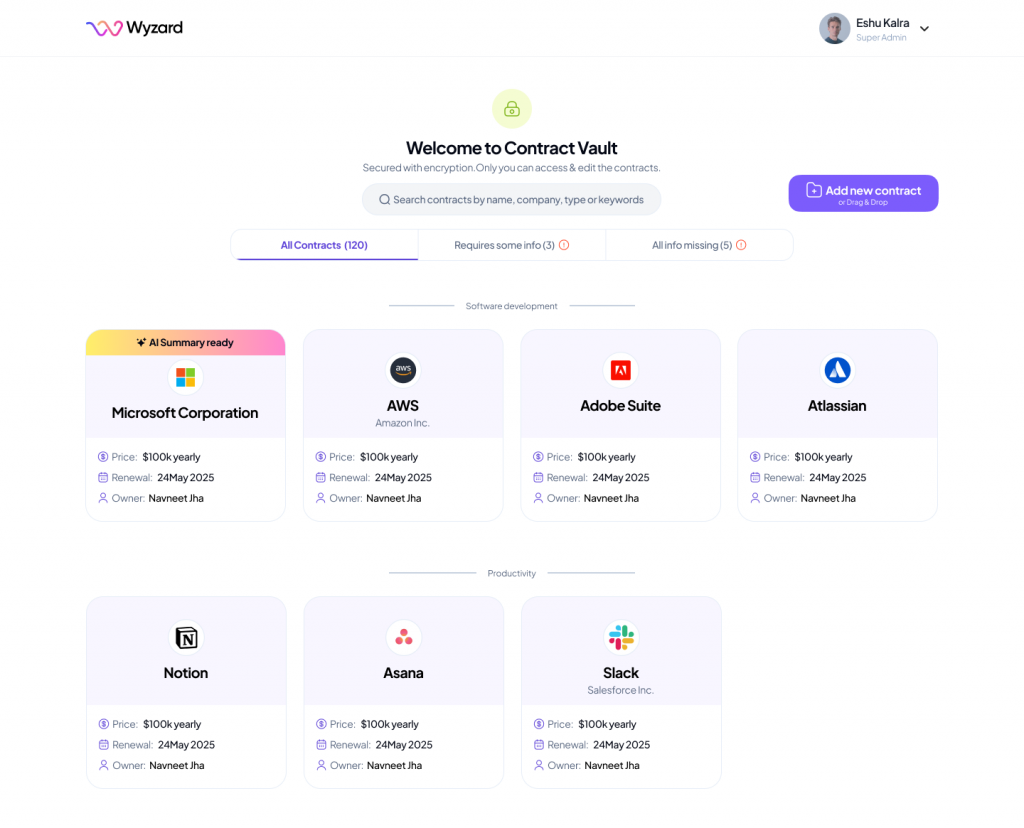
- With advanced automation tools, Wyzard ensures you never miss renewals by reminding you 90 days in advance.
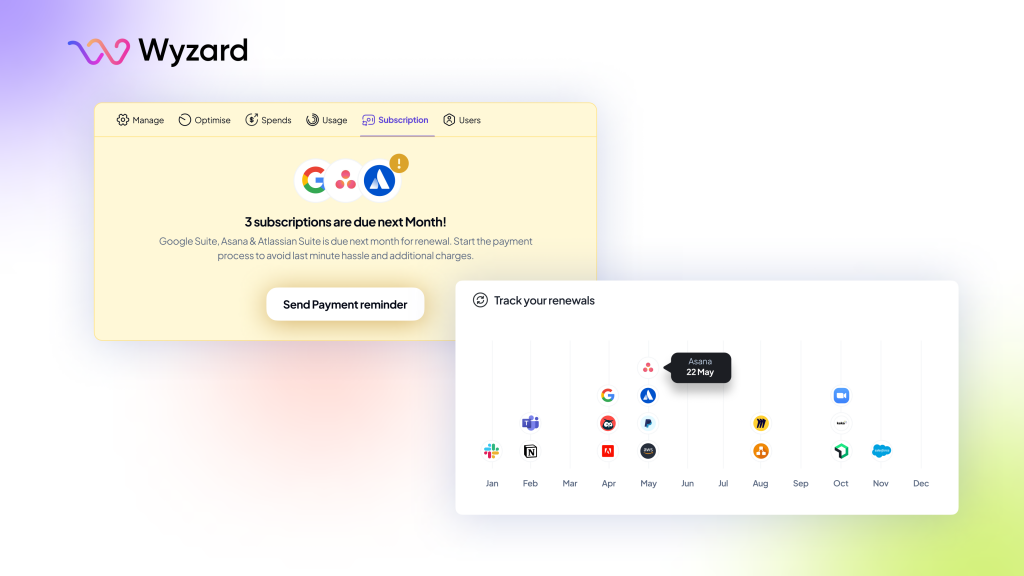
- Wyzard’s app usage insights show how your teams use software, providing valuable data for re-negotiating with vendors during renewals and procuring affordable subscriptions.
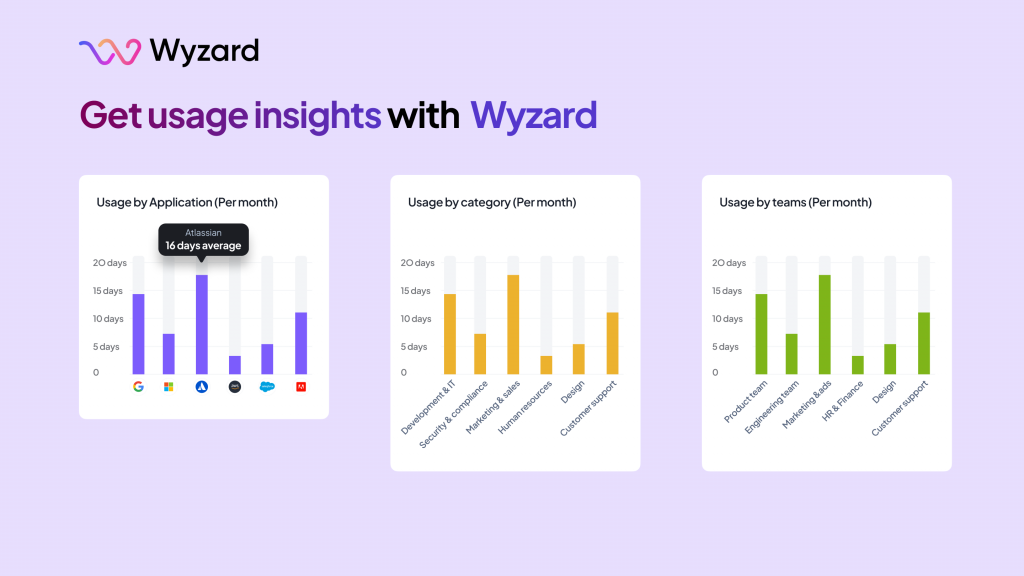
- It ensures that your chosen SaaS covers all bases, from security to compliance, addressing key concerns across industries.
- Wyzard suggests better software options available in the market based on your specific needs, helping you make informed decisions.
- During negotiations, Wyzard considers your usage data, license requirements, buying power, and industry benchmarks to help you secure the best deals.
Using Wyzard’s capabilities, you can avoid costly SaaS buying mistakes and optimize your software procurement process. Book a demo today!
Other blogs
The latest industry news, interviews, technologies, and resources.
March 17, 2025
How LLM-Based AI Agents are Simplifying the Software Buying Process for Businesses
Let’s talk about something that’s becoming a game-changer in our daily lives: AI agents. Think of them as your ...

March 11, 2025
Is Your Business Ready for CRM Software? Find Out Now!
Running a small business can feel like juggling a million things at once. You are busy with customers, ensuring ...

Subscribe
Today!
Error: Contact form not found.
Subscribe to learn about new product features, the latest in technology, solutions, and updates.
 Meet Us at
Meet Us at 


